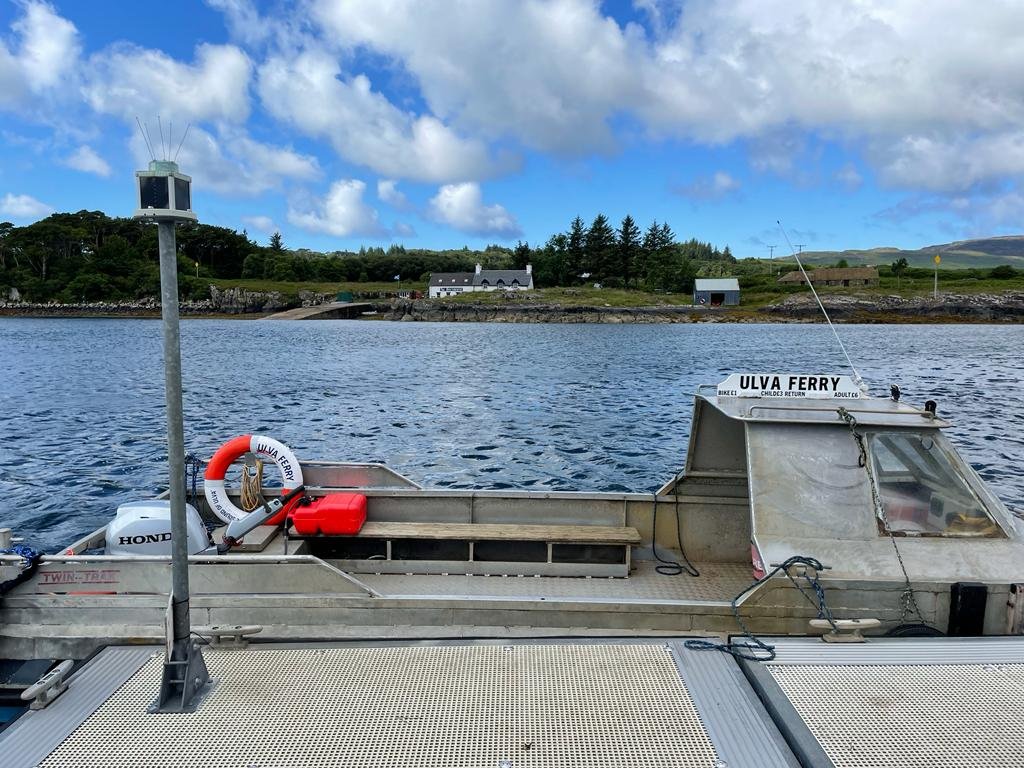The Road to Restoration
The Scotsman, Aug 2022
To reach the shores of Wolf Island, off the western edge of the isle of Mull, one must first negotiate the Sound of Ulva: a narrow, rock-and-islet-strewn strait, linking the sea lochs of na Keal and Tuath. To do this, would-be passengers summon the ferry by turning a hand-painted red wooden sign, located high on the pier – and waiting. The craft, when it arrives, is perhaps the smallest ferry, making the briefest Atlantic crossing in all of Scotland. And if there’s a better way to spend six pounds, I’ve yet to find it.
Of course, despite the fact that Wolf Island is incalculably cooler, few have called the place by its Viking name for a thousand years. Today it’s known as Ulva, a corruption of the Norse. A remote, compact, and heartstoppingly beautiful island, 20 winding miles and 40 waterborne seconds from Tobermory.
From the head of the slipway, the Boathouse restaurant commands spectacular views of the water. Promising fine local seafood, home baking, and, as my travel companion is excited to point out, the tantalising prospect of ‘A wee coffee’, it alone looks worth the trip. But we’ll be back to sample their fare in a few hours. First, with the sun glittering off the loch, and the breeze, with luck, whipping away the midges, we’ve an island to explore.
Of the several well marked routes, we choose the Ormaig and Kilvekewen walk. Eight miles, all told, or about a four-hour round trip. Making for the southern coast, the path first coils past the old boathouse, then Sheila’s cottage, a restored thatch and stone croft house. We pass a little industry just back from the water’s edge. Amphibious all-terrain vehicles and site huts, evidence of the housing renovation programme. Just one of the ways the community – which bought the island in 2018 – is trying to bring people, and with them social and economic security, back to the island. As we head deeper inland from the coast, a hush descends. A heavy silence broken only by the trickling of the burn, and the sibilant whisper of a waterfall.
It still strikes me as strange, and rather wonderful, stumbling upon these pockets of mature native woodland in the Hebrides, particularly broadleaf trees. The low, exposed islands of nearby Coll, Tiree, Rùm, and Eigg – places I love dearly – have spectacular beaches, but next to no trees. Here there are venerable old oaks, laburnum, cherry, sycamore and walnut. Even the occasional elm defying the odds. Though much of the island is exposed moorland, bracken and machair, these magical green enclaves lend the place an ancient, fairytale atmosphere. As if at any moment a malevolent kelpie might peer out from behind a moss-covered boulder.
Out in the open it’s warm, thirsty work. The track continues to climb as the trees fall away. In places it’s boggy and treacherous. Once, 600 people made their homes here. 16 villages spread out over 12 rocky kilometres, mostly kelp farmers. Decimated by famine, and the ravages of the clearances, by the beginning of the twentieth century their numbers had dwindled drastically. Today the population stands at just 11. After an hour or so of rough going, during which we are entirely alone, the coast appears below us. The small isles of Little Colonsay, Staffa, and Inch Kenneth rising like the backs of great emerald monsters. In the distance, the outstretched arm of southern Mull, Iona, and beyond that – if one could see so far – clear water to Malin Head: the uppermost tip of Ireland.
Three hours later, footsore and famished, back at the Boathouse, it’s time for lunch. We find a wooden table perched on its own, on a little grassy rise. With the island to our backs, it looks out over Loch na Keal and the mountains beyond. Two yachts ease their way up the channel. It’s too hot for coffee, so instead we (by which I mean I) partake of two ice cold beers, in quick, glorious succession.
Mark Elliot and Brendan Tyreman took over the restaurant’s lease a little over a year ago, relocating to the island from Edinburgh and fulfilling a rural dream that many might envy, but few would so impressively embrace. Their menu is short and flexible, responsive to the availability of the freshest produce, and all the better for it. Locally sourced seafood, Mull cheeses, homemade seaweed chutney and slowly fermented home baked bread. Seasonal ingredients, imaginatively prepared. It’s refreshing, frankly, with views like these – and a literally captive audience – to find such obvious care on the plate. We opted for the Tobermory smoked trout, with capers, red onion and mayonnaise, and creel caught Ulva crab, served with salad and homemade pickles. The trout is subtle, smoky, luxuriant (and plentiful), pairing well with the punchy citrus tang of the capers, and the crisp sweet onions; the potted crab, smothered onto thick, soft bread, is rich and mouthwateringly buttery. In fact, I’d say the food, like the view, is restorative.
Ferries to Ulva run Mon-Fri, 9-5:30 + Sundays in June, July, Aug. No ferries on Saturdays. The Boathouse is open 9-5 Mon-Fri + 11-5 on Sundays. Closed Saturdays.




